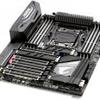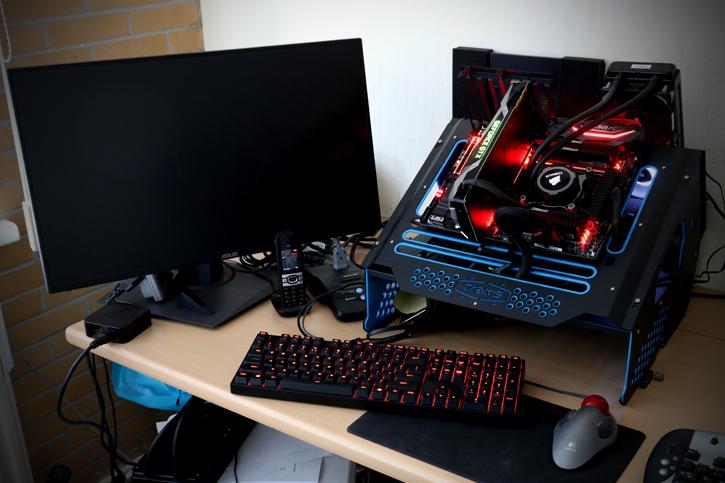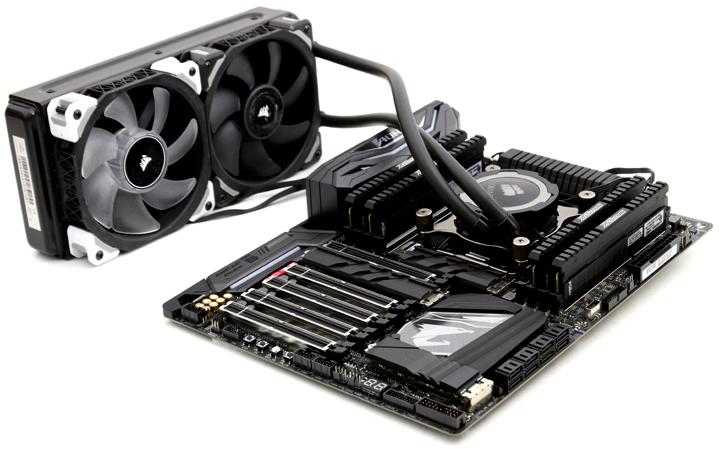Final Words & Conclusion
Final words & conclusion
With the Aorus Gaming 7 PRO Gigabyte offers a very high-end X299 motherboard, it is fitted with some awesome stuff and excellent features. Great to see is the new VRM design, one of the strongest we've seen thus far on any X299 motherboard, which is a necessity if you pass that 10-cores versus power consumption. The motherboard is lovely as it has very sweet looks (once powered on), an okay feature-set and a strong basis for overclocking. Lacking, however, is a bit of Ethernet extravaganza in the form of 5/10 Gbps Ethernet jacks. Overall the Gaming 7 PRO offers pretty much what the X299 chipset can push, but that still is very feature-rich and being Gigabyte, this is a well-designed motherboard. There is little you would disagree with me on that one. In this price category, it is nice to see that third M2 slot. The looks overall are lovely in its black look (though looks are personal and thus a subjective preference). Gigabyte also offers an easy to tweak platform from within their UEFI BIOS. The LED design is not too much out there but intricate enough to impress. The primary graphics card PCI-Express slots have been LED lit as well, honestly, it looks incredibly cool.
Performance
With the current BIOS firmware, the processor temps remain quite modest at ~70 Degrees C under full load conditions. Once overclocked Gigabyte seems to be bypassing the Intel recommended p-state spec as you can clearly see from power consumption levels, but currently is tweaking more and more at firmware levels to get those levels a bit more normalized. Intel right now tries to enforce a processor power state that keeps energy power consumption of a bit more in line. With most synthetic benchmarks you will not notice huge perf differences. Tweaked, our 10-core proc at 4500 MHz on all cores passed 400 Watts under heavy CPU load.
Tweaking
Depending on the choice of cooling, temperatures when the CPU is overclocked with added voltage, you are in for a challenge when compared to the last-gen Broadwell-E procs. Realistically if you already are on that or a Haswell-E platform, really there's little to get excited about upgrade wise. At the OC level you are looking at up-to 1.25~1.30V needed on that CPU core (depending on your frequency target and the number of tweaked cores). Tweaking wise the infrastructure that X299 offers is easy to use, you increase the CPU voltage and multiplier and you are good to go. With a Core i9 7900X and a good LCS (liquid cooling) kit you can achieve roughly 4500~4700 MHz. For memory, the sky is the limit as the Intel platform is that over the years they have been able to refine their memory controllers, pop in anything XMP 2.0 and you have a 90% chance it'll work straight out of the box with very fast memories. However, the effect of fast clocked memory is far less significant for Intel opposed to AMD Ryzen. Also with quad-channel memory available as an option, we'd always suggest to go with a more affordable 2677 MHz kit, as bandwidth on quad-channel simply is not relevant to your gaming experience. You are better off with more memory. Voltage wise we can recommend you to leave that CPU voltage at 'auto', this got us towards 4500 stable and keeps the temps in-line at sub-90 degrees C (if you can call that in-line). You will need some sort of liquid cooling as the 10 cores heat up pretty badly once you tweak.
Power consumption
Depending on the hardware p-state the motherboard is fitted with, your numbers will be all over the place. So, with ten cores you get a 140 Watt TDP processor. With the system at idle with a GeForce GTX 1080 installed / 16 GB memory / SSD and the X299 motherboard, I hovered at roughly 75 Watts in IDLE with the newest BIOS. That's just fine really, the load values are however significant. When we stressed the processor in a 100% run we reach roughly 300 Watts with this is a ten core part (it was a Prime 1024M stress test though). So, we go from 75 Watts towards 300 Watts. When we game we hover at 320 Watts with the GeForce GTX 1080, but obviously that factor is dependant on the type of graphics card you use of course and, sure, most games certainly do not utilize the ten CPU cores.
Something to keep in mind
We quickly have to discuss PCI-Express lanes, as honestly here is Intel just goofing up. Here is the breakdown:
- Kaby Lake-X quad core gets 16 PCI-Express Lanes 3.0
- Skylake-X six and eight core procs get 28 PCI-Express Lanes 3.0
- Skylake-X ten core procs get 44 PCI-Express Lanes 3.0
DDR4 Memory
Ever since Haswell-E was released along came DDR4 memory. With Skylake-X DDR4 may be clocked a notch faster at 2,677 MHz. Honestly, if you pick up some nice 2,133 MHz DIMMs, at quad-channel they'll offer more than plentiful bandwidth. A 3,200 MHz kit, for example, is far more expensive and does offer better bandwidth but the performance increases in real-world usage will be hard to find. Unless you transcode videos over the processor a lot. DDR4 mostly was released for lower voltages and higher frequencies. 2,133 MHz CL 14 or CL 15 memory combo with quad-channel will already get you to 50~60 GB/sec. While impressive to observe for gaming you will not notice huge performance improvements with high memory bandwidth, but with content creation and video transcoding, this kind of bandwidth certainly does make a difference. As always, my advice would be to go with lower clocked DDR4 memory with decent timings, but get more of it. Don't go for 8 GB, get four DIMMs and in total a minimum of 16 GB. And yeah, if you do not care about spending money, check the test page with the G.Skill RGB DIMMs at 3600 MHz, that is brilliant stuff though.
Concluding
There's no denying it, the Gigabyte Aorus X299 Gaming 7 PRO is one of our favorite high-end motherboards for Skylake-X. The PRO model has an improved VRM area that can eat all and many (18) core processors, and that's quite lovely really. The Gigabyte Aorus X299 Gaming 7 Pro is in our opinion one of the most desirable X299 motherboards and also a true feast for the RGB enthusiast. An excellent choice, it was properly designed and is fine looking. Everything in a PC is all about the symbiosis of all components, and thus this symbiosis can only be as good as the processor will allow it to be. Looking at purely the motherboard then it is all very simple, it is lovely and features rich enough, has a proper nice dark design and is well built with proper components. Features wise this kit offers many SATA 6 Gbps ports, the Intel/Killer Ethernet jacks, AC WIFI, improved 7.1 channel HD audio and even three M2 slots. Gigabyte did not go over the top with RGB LEDs and did things subtle, I like that as well. The Gigabyte X299 Aorus Gaming 7 PRO is easily recommended for what it is, a quality motherboard. However, pricing (at the time of writing) indicates a price position in the 449 euro/USD range. I find that to be rather steep. Other then that, it's a fantastic motherboard really.
Handy related downloads:
- Sign up to receive a notice when we publish a new article
- Or go back to Guru3D's front page.




